Compiled by Keith Newman with help from many resources. Contributions and corrections welcome
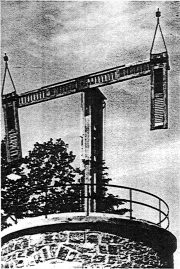
1200
BC - Homer talks about
signal fires in the Illiad.
700 BC to 300 AD - Carrier pigeons used in Olympic games
200 BC
to 100 BC
- Human messengers on foot or horseback common in Egypt and China
with messenger relay stations built. Sometimes fire messages used from
relay station to station instead of humans.
37BC -
Heliographs - first recorded use of mirrors to send messages by Roman
Emperor Tiberius.
11BC - Romans
establish postal services.
1560 - Camera
Obscura invented - primitive image making.
1588 - Arrival of the Spanish Armada announced by signal fires
1714 -
Englishmen, Henry Mill receives the first patent for a typewriter.
1791
- Precursor to semaphore. The Chappe brothers, in France obtain
permission to set up a signaling system so they can send messages to
each other using movable arms on a pole with positions denoting letters
of the alphabet.
1793 - The Chappe brothers established the first commercial
semaphore system between two locations near Paris. Napoleon loved it and
soon there were semaphore signaling systems covering the main cities of
France. It spread to Italy, Germany and Russia with thousands employed
manning the stations. About 125 characters per minute were possible.
Code books were used to represent whole sentences in a few moves.
Semaphore wasn't so successful in England because of the fog and smog of
the Industrial Revolution. There were also semaphore systems in the U.S.
The last operational semaphore system was in Algeria and went out of
business in 1860.
1821 - Charles
Wheatstone reproduces sound in a primitive sound box - the first
microphone.
1830 -
the great American scientist Professor Joseph
Henry transmitted the first practical electrical signal; showing that
electromagnetism could do more than just create current or pick up
heavy weights -- it could communicate.
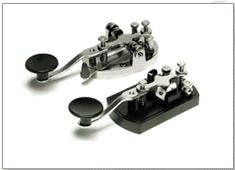 1837 - Cooke and
Wheatstone obtain a patent on telegraph. Morse publicly
demonstrates his telegraph.
1837 - Cooke and
Wheatstone obtain a patent on telegraph. Morse publicly
demonstrates his telegraph.
1840
- Congress was requested to provide funding for a semaphore system
running from NYC to New Orleans.
Samuel
Morse, it is said, advised against funding of this system because of
his work on developing the electric telegraph.
1843 - The FAX invented by the Scotch physicist Alexander Bain.
1844 - Morse demonstrates the electric telegraph by sending a
message to Baltimore from the chambers of the Supreme Court in
Washington, DC. The message, "What hath God wrought?," marks the
beginning of a new era in communication.
1844
- Morse's first telegraph line between Washington and Baltimore opens in
May.
1847 (March 3) - Birth of Alexander Graham Bell,
Edinburgh, Scotland.
1851 - There are 51 telegraph companies in operation
1856 - Western Union formed by six men from Rochester, N.Y. They
start an acquisition spree.
1858 - Burglar Alarm - Edwin T. Holmes of Boston begins to
sell electric burglar alarms. Later, his workshop will be used by
Alexander Graham Bell as the young Bell pursues his invention of the
telephone. Holmes will be the first person to have a home telephone.
1860
Philipp Reis develops a telephon.
1861 - Both coasts are connected. There are now 2250 telegraph
offices in operation nationwide.
1865 - Maxwell
mathematically predicts the propagation of electromagnetic waves through
space.
1866
- First transatlantic telegraph line successfully laid. Prior to the
cable, sending messages between the US and Europe took 11 days.
Uninterrupted
transatlantic communications are established with the successful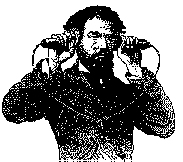 laying of the first telegraph cable on 27 July.
laying of the first telegraph cable on 27 July.
1867 - The first Atlantic
cable, promoted by Cyrus Field, was layed on July 27th.
1870 - Thomas Edison invents multiplex telegraphy.
1871 - Bell arrived in Boston in April to start his work
in the teaching of the deaf.
1872 - Western Union buys the telegraph equipment manufacturing
firm, Gray & Barton, and renamed it Western Electric.
1874
- Alexander Graham Bell discovered the principle of the telephone.
1875 - Bell's theory of the telephone confirmed by
experiment, June 2 . First words transmitted by telephone
1876 -The first telephone patent, No. 174,465 was
issued to Alexander Graham Bell onMarch 7. The first complete sentence
of speech transmitted by telephone in Boston. three days later.
US Patent No.
174,465, issued on March 3 for 'Improvements in Telegraphy'.
Elisha Gray applies for a similar patent hours after Bell.
Edison invents the electric motor and the
phonograph
1877 - Thomas
Edison receives a patent in Britain for the 'electro-motograph'. First
permanent outdoor telephone wire strung. Commercial telephone service
began in the United States.
Bell Telephone Company formed, with Alexander Graham Bell as
"electrician" and Thomas Watson as "superintendent."
1878 - First commercial telephone exchange in the world
opened at New Haven, Conn, January 28.
1880 - American Bell founded. 30,000 phones in use. Bell spoke
over a 1300-ft beam of light using his patented Photophone equipment.
1884 - Paul Nipkow obtains a patent in Germany for TV, using a
selenium cell and a mechanical scanning disk. First long distance call:
Boston to NYC.
1885 - The Bell Telephone Company formed a new subsidiary,
American Telephone & Telegraph (AT&T).
1890 - Herman Hollerith gets a contract for processing the 1900
census data using punched cards. His firm was eventually named
IBM in 1924
1892 -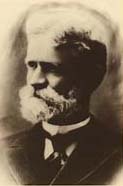 Almon Strowger, the St. Louis undertaker, became upset on finding
that the wife of a competitor was a telephone operator who made his line
busy and transferred calls meant for him to her husband. "Necessity is
the mother of invention" so Strowger developed the dial telephone
system to get the operator out of the system. He forms a Chicago
firm, Automatic Electric, to manufacture step-by-step central office
equipment (which is now owned by GTE).
Almon Strowger, the St. Louis undertaker, became upset on finding
that the wife of a competitor was a telephone operator who made his line
busy and transferred calls meant for him to her husband. "Necessity is
the mother of invention" so Strowger developed the dial telephone
system to get the operator out of the system. He forms a Chicago
firm, Automatic Electric, to manufacture step-by-step central office
equipment (which is now owned by GTE).
1893 - An early form of broadcasting was started in
Budapest over 220 miles of telephone wires serving 6000 subscribers who
could listen at regular schedules to music, news, stock market prices,
poetry readings and lectures.
1895 - Guglielmo Marconi invented the radio.
1896
- Marconi patents wireless telegraph.
1901
- Marconi signals the letter "S" across the Atlantic from England to
Newfoundland. The first radio message is sent a year later.
1902 -
Trans-Pacific telephone cable connects Canada
and Australia.
1903 -
Technical improvements in radio, telegraph,
phonograph, movies and printing.
1904 -
A telephone answering machine is
invented.
1906
- Lee deForest invents the vacuum tube
1907
- United States start to regulate telcos.
1907
- The
world's first transatlantic commercial wireless services is
established by Marconi with stations at Clifden, Ireland and Glace Bay,
Nova Scotia
1909
- Marconi shares the Nobel Prize in Physics, with Karl Ferdinand Braun
for their work in the development of wireless telegraphy
1910 - The first
commercial radios are sold by Lee de Forest's Radio Telephone
Company
1911: Sound arrives for motion pictures.
1913 – Strowger
system introduced in Australia and New Zealand. Development of key-type
impulse sender, and Simplex dialing on toll lines.
1914: First transcontinental telephone
call.
1915
- Vacuum tube amplifiers used the first time in coast-to-coast
telco circuits. In opening the service, Bell, in New York, repeated his
famous first telephone sentence to his assistant, Mr.Watson, who was in
San Francisco, "Mr. Watson, come here, I want you." Watson replied, "If
you want me, it will take me almost a week to get there."
1915 -
The electric loudspeaker.
1919 -
Shortwave radio invented
1920
- Electric sound recording achieved.
1921 -
Quartz crystals keep radio signals from
wandering. Wirephoto -
The first electronically-transmitted photograph is sent by Western
Union.
1922
- Ship-to-shore conversation
by wire and wireless between Bell telephones in homes and offices and
the S. S. America 400 miles at sea in the Atlantic.
Alexander
Graham Bell dies at his summer home in Beinn Breagh, near Baddeck, Cape
Breton Island, Nova Scotia (August 2). Telephone service is suspended
for one minute (6:25pm-6:26pm) on the entire telephone system in the
United States and Canada during the funeral service (4 August). British
Broadcasting Corporation (BBC) is formed.
1923
- A picture, broken into dots, is sent
by wire.
1923 -
16 mm nonflammable film debuts.
1924 -
Pictures are transmitted over telephone lines.
1925
- Bell Telephone Laboratories
founded. 1.5 million dial telephones in service out of 12 million phones
in service
1926
- Baird in Scotland and Jenkins in the U.S. demonstrate TV
using neon bulbs and mechanical scanning disks. P.M. Rainey at
Western Electric patents the PCM (pulse code modulation) methodology.
1927 - Television - Philo Farnsworth demonstrates the
first television for potential investors by broadcasting the
image of a dollar sign. Farnsworth receives backing and applies for a
patent, but ongoing patent battles with RCA will prevent him from
earning his share of the multi-billion-dollar industry his invention
will create. Jolson's The Jazz Singer
is the first popular "talkie."
1928 -
IBM adopts the 80-column punched card.
1929 -
Ship passengers can phone relatives ashore.
Magnetic sound recording on plastic tape. The first telephone is
installed on President Hoover's desk. Up to this time, the President
talked from a booth outside his executive office. First public
demonstration of television, in color, is made at Bell
Laboratories in New York on June 27th.
1930 -
AT&T tries the picture telephone.
1931 - Radio
Astronomy - While trying to track down a source of electrical
interference on telephone transmissions, Karl Guthe Jansky of
Bell Telephone Laboratories discovers radio waves emanating from stars
in outer space
1933
- Edwin Armstrong demonstrates frequency modulation (FM) to
Sarnoff but its real future is 20 years off.
Phonograph records go stereo.
1934 - Joseph
Begun invents the first tape recorder for broadcasting - first magnetic
recording.
1935
- The first around-the-world telephone conversation takes place. (April
25)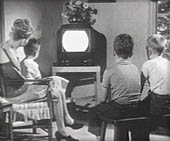
Western Union's "Telefax" begins operating. Telefax sent
telegrams, manuscripts, line drawings, maps and page proofs for
magazines
1936: Alan
Turing's On Computable Numbers describes a general purpose
computer.
Invention of coaxial cable is announced at a joint meeting of the
American Physical Society and the IRE
1937: Stibitz
of Bell Labs invents the electrical digital calculator. Pulse
Code Modulation points the way to digital transmission. Carlson invents
the photocopier.
1938
- The power of radio is demonstrated by Orsen Wells with the broadcast
of War of the Worlds. This causes telephone traffic to
peak in nearly all cities and on long distance lines.
1940: Broad band carrier systems are
introduced allowing for simultaneous calls over a single pair of wires.
1942
- Atanasoff Berry builds the
first electronic digital computer.
1945 -
Arthur C Clarke envisions
geo-synchronous communication satellites
1946 -
ENIAC heralds the modern electronic computer.
1947 -
The transistor is invented
- enabling the
miniaturization of electronic devices.
Cellular systems first discussed.
1948 - Long
playing record invented - vinyl and played at 33 rpm.
1949 - Network
television starts in U.S. 45 rpm record invented.
1950
- The volume of telephone calls reaches 180 million a day in the US, 75
per cent
of lines are party lines. There are 72 television stations in 42 cities
across the US, making it available to half the population.
1951 -
Computers are sold commercially.
1954 -
The USSR launches Sputnik. Radio sets now
outnumber newspapers printed daily. Regular colour TV broadcasts begin
in the US.
Gene Amdahl
developed the first computer operating system for the IBM 704.
Sony introduces the first transistor radio that sold for $US49.95.
Raytheon introduces the transistor for hearing aids replacing its line
of subminiature tubes. Zenith's highly successful hearing aids using
subminiature tubes, about the size of a pack of cigarettes with a
separate battery pack sold for about $25.00. The first in-the-ear
hearing aids appeared about 1955-1956.
1956 -
First transatlantic telephone calls by cable.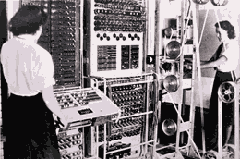
1957 -
Soviet Union's Sputnik sends signals from
space, FORTRAN becomes the first high-level language.
1958 -
Data moves over regular phone circuits,
broadcast bounced off rocket, pre-satellite communication, the laser.
1959 -
The microchip is invented.
1960
- ECHO I communications satellite is launched on 12 August. Provides
first satellite television broadcast of 1962. Laser is invented
1961 -
IBM Germany comes up with "Tele-Processing",
data which can be transmitted over the phone to another computer. Bell
Labs tests communication by light waves. IBM introduces the
golf ball typewriter. A time-sharing computer is developed.
1962 -
The minicomputer arrives. A satellite
transmitted the first television images and telephone calls
1963
- Communications
satellite placed in geo-synchronous orbit.
1964 -
Intelsat, international satellite
organisation formed.
1965 -
The space probe
Mariner 4 passed Mars closer than 10000 km (6200 miles). 21 pictures
were transmitted via radio along with data about the atmosphere.
1966 -
Scientist Charles Kao from USA firstly used
light conductor fibre to transmit phone calls. The property of
homogeneous glass fibre, to conduct light without distortion was
also discovered by Narinder S. Kapany in 1955. Kao sends invisible
electromagnetic waves through an extremely thin glass fibre.
1967 -
Cordless telephones get some calls.
1967 -
Approx. 200 million telephones in the world,
half in U.S.
1968 -
Intelsat completes global communications
satellite loop.
1968 -
Photo telegraphy. German electronic firm
Grundig introduced a small band picture transfer process, enabling
transfer of TV pictures by telephone. Within a minute a photographic
recording could be printed.
1969 -
ARPANET
was established to link four universities. The universities were
Stanford Research Institute, University of CA at LA, University of CA at
Santa Barbara, and the University of Utah.
Soon, methods were built into the system for file
transfer and for electronic mail (email). The net kept functioning when
one or more lines went down by switching to others lines using dynamic
rerouting. The internet was born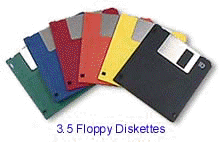
1970
- Time division multiplex (TDM) and
direct dial introduced, the computer floppy disc is an instant
success.
1971 -
Intel builds the microprocessor, "a computer
on a chip.", Wang 1200 is the first word processor,
Rank Xerox puts the first telecopier onto
the market. Project Gutenberg is started by
Michael Hart with the purpose of making copyright-free works, including
books, electronically available. The first text is the US Declaration of
Independence
1972 -
Digital television comes out of the lab. The
first international connections to ARPANET established. Ray Tomlinson (BBN)
modifies email program for ARPANET where it becomes a quick hit. The
@ sign was chosen from the punctuation keys on Tomlinson's Model 33
Teletype for its "at" meaning
1973 -
Bob Metcalfe's
Harvard PhD Thesis outlines idea for Ethernet which is tested on
Xerox PARC's Alto computers. The first Ethernet network is called the
Alto Aloha System. Bob Kahn starts Internetting research
program at ARPA. Vinton Cerf sketches gateway architecture on
back of envelope in a San Francisco hotel lobby in March. Cerf and Kahn
present basic Internet ideas at Univ of Sussex, Brighton, UK
1974
- Cerf
and Kahn publish design of a Transmission Control Program (TCP).
The BBC transmits Teletext data to TV sets.
Hewlett-Packard introduces the first programmable pocket calculator
the HP-65.
1975 -
The microcomputer kit reaches hits the home
market, IBM introduces laser printers on the market,
1976: Queen Elizabeth II sends out an email on 26 March from the Royal
Signals and Radar Establishment (RSRE) in Malvern
1976 - Apple I
home computer invented.
1978 -
TCP split into TCP and IP
1979 -
Sony develops the small radio-cassette
player, Inmarsat is founded, the Japanese firm Matsushita is granted
a patent for a TV screen made out of liquid crystals. CompuServe goes on
line. The number of subscriber telephone lines in the United States is
now 175.2 million.
First cellular phone communication network started in Japan.
1980 -
Microchip
capacity increases to register up to 6400 bits and are used in computers
(RAM & ROM). The first pocket computers arrive and British
engineers bring the first home computer, the Sinclair ZX 80 to market.
Broadband transmission using the MHz bandwidths is formalised.
ARPANET grinds to a complete halt on 27 October
because of an accidentally-propagated status-message virus
1981 -
The IBM PC,. MS-DOS was developed by Microsoft
and marketed by IBM, the laptop computer, The first mo use
pointing device. Multi-channel sound introduced for broadcasting, first
CD players and compact disks introduced. Minitel (Teletel) is deployed
across France by France Telecom, mainly used for porno not directory
information as planned.
use
pointing device. Multi-channel sound introduced for broadcasting, first
CD players and compact disks introduced. Minitel (Teletel) is deployed
across France by France Telecom, mainly used for porno not directory
information as planned.
1982
- The protocol that carries most of the
information across the web, TCP/IP Protocol established, the
Telefax or is introduced in Germany, Great Britain and Sweden which
transmits messages from text machine to another typing machine at
a speed of 1200 bit/s.
1983: Time names the computer "Man of the Year",
AT&T forced to break up; seven Baby Bells
are born. The scramble begins within AT&T to divest itself. ISDN
trials begin in Japan. The U.S. has its first cellular subscriber.
Microsoft announces Windows.
1984 -
Apple Macintosh, IBM PC AT, the 32-bit
microprocessor, the one megabyte memory chip. Internet Domain Name
System (DNS) introduced. Moderated newsgroups introduced on USENET. Cult
sci-fi book Neuromancer by William Gibson inspires net
community.
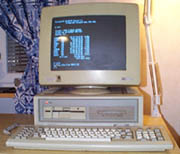
1985 -
CD-ROM stores 270,000 pages of text,
the first version of Microsoft Windows,
cellular telephones in cars become wide-spread. CD-ROMs in computers.
1986
- NFSNET established to link five
supercomputers which becomes the network backbone for the Internet
1987
- The earth is mapped from space. The
survey of the surface is done by means of navigation satellites. The
digital-audio-tape (DAT) is introduced. The US reaches its one
millionth cellular subscriber. ISDN trials begin in the United
States.
1988 -
The first transatlantic fiber optic cable
is completed. The Morris internet worm burrows through the net affecting
6000 of the 60,000 hosts. NSFNET backbone upgraded to T1 (1.544Mbps).
Internet Assigned Numbers Authority (IANA) established in December with
Jon Postel as its director. Internet Relay Chat (IRC) developed by
Jarkko Oikarinen
1989:
Number of hosts breaks 100,000. The
World Wide Web invented by Tim Berners Lee.
Cuckoo's Egg by Clifford Stoll
tells the real-life tale of a German cracker group who infiltrated
numerous US facilities. Countries connecting to NSFNET: Australia (AU),
Germany (DE), Israel (IL), Italy (IT), Japan (JP), Mexico (MX),
Netherlands (NL), New Zealand (NZ), Puerto Rico (PR), United Kingdom
(UK) .Digital satellite broadcasting starts in Germany. The High
Definition Television is presented. Space probe Voyager 2 transmits
signals 4.4 billion kilometres from the planet Neptune. The first
ISDN communications system is established in Rotterdam as an extension
of the public telephone network, designed to carry digitised voice
calls, or data.
1990 -
Microsoft releases Windows 3.0 a completely new
version which will sell more then 3 million copies in one year. Creative
Labs introduces SoundBlaster Pro. The first search engine Gopher
is developed at the University of Minnesota. Intel releases the 80386SL
processor which uses low power for portable computers. Telecom New
Zealand becomes the first carrier to be completely privatised.
Electronic Frontier Foundation (ELF) founded by Mitch Kapor. The
World comes on-line world.std.com becomes the first commercial provider
of Internet dial-up access. The first remotely operated machine to be
hooked up to the Internet, the Internet Toaster by John Romkey,
(controlled via SNMP) makes its debut at Interop.
1991
- Following its decision not to develop
operating systems cooperatively with IBM, Microsoft changes the name of
OS/2 to Windows NT,
Pretty Good Privacy more commonly known as PGP
a public key used for encryption is released as Freeware by Philip
Zimmerman. TrueType a scalable
font is introduced and developed by Microsoft and Apple and is
used on all Apple computers and PC computers running Windows.
MS-DOS 5.0 is released. NSFNET backbone
upgraded to T3 (44.736Mbps) traffic passes 1 trillion bytes/month and 10
billion packets/month.
1992 -
Microsoft introduces Windows 3.1which sells
more than 1 million copies in the first two months, Intel releases the
486DX2 chip, TWAIN a standard interface for scanning is developed
by a consortium Aldus, Caere, Eastman, Kodak, Hewlett Packard and
Logitech.
One-millionth
host connected to the Internet, with the size now approximately doubling
every year. The term 'surfing the internet' is coined by Jean
Armour Polly
1993 -
There are 50 known World Wide Web servers.
Internet
Protocol version 4 (IPv4) established for reliable transmission over the
internet in conjunction with the Transport Control Protocol (TCP).
Intel releases the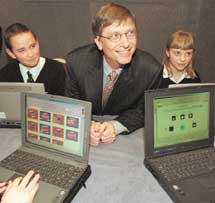 Pentium Processor. operating at 60 MHz. Windows NT 3.1 and
Windows for Workgroups 3.11 released, the first browser Mosaic is
launched in April and takes the Internet by storm, Web proliferates
at a 341,634% annual growth rate of service traffic. Gopher's growth is
997%.. Worms of a new kind find their way around the Net - WWW Worms
(W4), joined by Spiders, Wanderers, Crawlers, and Snakes ... Internet
Talk Radio begins broadcasting. Businesses and media begin taking notice
of the internet. The PowerPC processor for the Apple PowerMac is
developed by IBM, Motorola and Apple. Computer games Doom and
Myst are released.
Asymmetric Digital
Subscriber Lines (ADSL) standardised using the discrete multi-tone
technique to allow greater services to be provided over the plain old
telephone service (POTS).
Pentium Processor. operating at 60 MHz. Windows NT 3.1 and
Windows for Workgroups 3.11 released, the first browser Mosaic is
launched in April and takes the Internet by storm, Web proliferates
at a 341,634% annual growth rate of service traffic. Gopher's growth is
997%.. Worms of a new kind find their way around the Net - WWW Worms
(W4), joined by Spiders, Wanderers, Crawlers, and Snakes ... Internet
Talk Radio begins broadcasting. Businesses and media begin taking notice
of the internet. The PowerPC processor for the Apple PowerMac is
developed by IBM, Motorola and Apple. Computer games Doom and
Myst are released.
Asymmetric Digital
Subscriber Lines (ADSL) standardised using the discrete multi-tone
technique to allow greater services to be provided over the plain old
telephone service (POTS).
1994
- Netscape is founded by Marc
Andreesen and James H. Clark, Commodore files for bankruptcy.
Rolling Stones live to 200 workstations worldwide on the MBone. A dozen
nations ban or restrict satellite dishes to reduce Western influence. US
vice president Al Gore coins the term 'information
superhighway'. The World wide Web Consortium (W3) is founded by
Tim Berners-Lee to help develop common protocols for the evolution
of the Web. Microsoft, Yahoo, another search engine site is
launched
1995 -
Windows 95 is released and within four
days sells more then 1 million copies the Universal Serial Bus
(USB) standard is released, There are now 25 million cellular
subscribers in the U.S. Worldwide, 30 million users are now on the
Internet. Traditional online dial-up systems Compuserve and
America On-line begin providing internet access. Richard White becomes
the first person to be declared a munition, under the USA's arms export
control laws, because of an RSA file security encryption program
tattooed on his arm
1996
- Google is first developed by
Sergey Brin and Larry Page.
AT&T spins off the system and technology
unit which renames itself Lucent Technologies, IBM's Deep Blue
supercomputer beats chess master Garry Kasparov in two chess
matches. Microsoft releases Windows CE. Sun Microsystems releases its
line of network computers.
1000Base-T
standardisation begins for 1Gbps Ethernet.
Internet phones catch the attention of US
telecommunication companies who ask the US Congress to ban the
technology which has been around for years. Various ISPs suffer extended
service outages, bringing into question whether they will be able to
handle the growing number of users. MCI upgrades internet backbone
adding 13,000 ports, bringing the effective speed from 155Mbit/sec to
622Mbit/sec. The Web browser war, fought primarily between Netscape and
Microsoft, has rushed in a new age in software development, whereby new
releases are made quarterly with the help of internet users eager to
test upcoming (beta) versions.
1997 -
Digital Video Discs / Digital Versatile Discs (DVDs)
go on sale. Windows 98, Office 97, Apple release Mac
OS/8. Microsoft invests $150 million in Apple Computers. Bill
Gates is now the world’s richest businessman. Intel Pentium II 233
MHz processor is released. The NASA Pathfinder Web site, running
real-time images from Mars gets more than 100 million hits in its first
four days forcing NASA to sets up 25 mirror pages to handle the traffic
which sets a new popularity record.
1998 -
Google founded by Sergey Brin and Larry Page,
Intel releases the Celeron processor, Compaq Computer
purchases Digital Equipment Corporation for $US9.6 billion ,
Hearings open between Microsoft and the U.S. Department of Justice
over claims of a monopoly in the software market.
Apple introduces the iMac, which helps address flagging sales.
Ericsson, IBM,
Intel, Nokia, and Toshiba announce they will join to develop
Bluetooth for wireless data exchange between handheld computers or
cellular phones and stationary computers.
The Worldcom purchase
of MCI is approved. SBC announces its plan to "merge" with Ameritech.
Bell Atlantic announces plans to merge with GTE.
Web size estimates range between 275 (Digital) and
320 (NEC) million pages

1999 -
The Intel Pentium III 500 MHz is released.
Organisations all around the world spend billions of dollars as they try
to make their telecommunications systems and networks Y2K compliant for
the turn of the century. MCI/Worldcom, the
vBNS provider for NSF, begins upgrading the US backbone to 2.5GBps, the
Melissa virus is released.
2000 -
Years
of preparation and billions of dollars result in the Y2K 'Bug'
prove an anti-climax but have forced major systems upgrades in
preparation for the next burst of growth in business and on-line
technology. Mergermania strikes. Lucent Technologies
announces spins off its enterprise solution group creating Avaya
Communications. Bell Atlantic and GTE announce that their new combined
company will be named Verizon (derived from the Latin for truth) moving
the "Bell" name into history. Cisco and Nortel networks jockey for
position as leaders in voice and data communications and the Internet.
A massive denial of service attack is
launched against major web sites, including Yahoo, Amazon, and
eBay in early February , Web size estimates by NEC-RI and Inktomi
surpass 1 billion indexable pages, Internet2 backbone network
deploys IPv6 in May, the Love Letter virus is released into the
wild.
The
year turns into a financial disaster for many so called dot com
companies as venture capital and high stock prices dry up resulting in
layoffs, bankruptcies having a snowballing effect on on-line industries
which will hereafter being known as the dotcom bomb.
2001 -
The dotcom bomb continues to take its toll and
the telecommunications industry worldwide heads for a slump.
Apple Computer introduced its new operating system OS-X,
Microsoft has its court-ordered breakup overturned settling the
antitrust case with the Department of Justice.
PC sales
slump. Napster keeps finding itself embroiled
in litigation and is eventually forced to suspend service; it comes back
later in the year as a subscription service, Code Red worm and Sircam
virus infiltrate thousands of web servers and email accounts in July
causing a spike in internet bandwidth usage and security breaches. Nimda
and BadTrans also appear. First uncompressed real-time gigabit HDTV
transmission across a wide-area IP network tak es
place on Internet2 .
es
place on Internet2 .
2002 -
Hundreds of internet radio stations
observe a Day of Silence in protest of proposed song royalty rate
increases, Internet2 now has 200 university, 60 corporate, and 40
affiliate members, having your own Blog becomes hip
2003 -
The first official Swiss online election takes
place in Anières. The SQL Slammer worm causes one of the largest and
fastest spreading DDoS attacks ever. Taking roughly 10 minutes to spread
worldwide, the worm took down 5 of the 13 DNS root servers along with
tens of thousands of other servers, and impacted a multitude of systems
ranging from bank ATM systems to air traffic control to emergency (911)
systems. This is followed in August by the Sobig.F virus, the fastest
spreading virus ever, then the Blaster (MSBlast) worm another
highly destructive internet interloper. The Recording Industry
Association of America (RIAA) sues 261 individuals on 8 Sep for
allegedly distributing copyright music files over peer-to-peer networks
![]() To be continued....
To be continued....
Email: wordman@wordworx.co.nz , Web: http://www.wordworx.co.nz
![]() Resources: Culled from the Timeline Media
History Project (URL) with additional research from
200 Year Condensed History of Telecommunicaitons ,Airwav's timeline
Airewav.com,
IEEE (
Institute of Electrical and Electronics Engineers ), The
Web
History of Telecommunications , Private Lin
Private Line (Telephone History), Computer Hopes
Computer
History pages, Webb & Associates
http://www.webbconsult.com/hist-time.html , Robert H Zakon's amazing
efforts at
Hobbes Internet
Timeline . Photographs from Union of Concerned Scientists (
http://www.ucsusa.org ),
Forbes (
www.forbes.com/2001/ 07/11/attindex.html
), Mercurians (
http://www.mercurians.org
),
A History of the Telephone
by Dawne M.
Flammger,
Cellular News ,
Resources: Culled from the Timeline Media
History Project (URL) with additional research from
200 Year Condensed History of Telecommunicaitons ,Airwav's timeline
Airewav.com,
IEEE (
Institute of Electrical and Electronics Engineers ), The
Web
History of Telecommunications , Private Lin
Private Line (Telephone History), Computer Hopes
Computer
History pages, Webb & Associates
http://www.webbconsult.com/hist-time.html , Robert H Zakon's amazing
efforts at
Hobbes Internet
Timeline . Photographs from Union of Concerned Scientists (
http://www.ucsusa.org ),
Forbes (
www.forbes.com/2001/ 07/11/attindex.html
), Mercurians (
http://www.mercurians.org
),
A History of the Telephone
by Dawne M.
Flammger,
Cellular News ,